Studying and understanding traffic signs and signals is crucial for passing the California DMV test as it assesses your knowledge of these critical elements of road safety and compliance. By familiarizing yourself with their meanings and functions, you will be better prepared to navigate the roads safely and pass the DMV test successfully.
Traffic Signs and Meanings
Traffic signs and signals in California are crucial for safety, traffic control, guidance, enforcement, hazard warning, pedestrian safety, consistency, and emergency communication.
| No. | Sign & Signal | Meaning |
| 1. |  |
An HOV lane is a special lane reserved for carpools, buses, motorcycles, or low-emission vehicles with decals. To use an HOV lane, one of these must apply:
• You have a certain number of people in your vehicle. There will be signs at the on-ramp or along the road to tell you the minimum number of people. Road signs also list the hours when the HOV rules apply. The road surface in a HOV lane is marked with a diamond symbol and the words Carpool Lane. Do not cross over double solid lines to enter or exit an HOV lane. Use designated entrances and exits. |
| 2. |  |
Some two-lane roads have special turnout areas or lanes. Merge into these areas or lanes to allow cars behind you to pass.
You must use a turnout area or lane to let other vehicles pass when you are driving slowly on a two-lane road, where passing is unsafe, and there are five or more vehicles following you. |
| 3. |  |
Parking for a disabled person or someone driving a disabled person with a special placard or special license plate. |
| 4. |  |
Local authorities can reserve parking spaces on public streets for electric vehicle charging. |
| 5. |  |
A red traffic signal light means STOP. You can turn right at a red light, if: • There is not a NO TURN ON RED sign posted. • You stop at the stop or limit line, yield for pedestrians, and turn when it is safe |
| 6. |  |
A red arrow means STOP. Do not turn at a red arrow. Remain stopped until a green traffic signal light or green arrow appears. |
| 7. |  |
A flashing red signal light means STOP. After stopping, you maygo when it is safe. |
| 8. |  |
A yellow traffic signal light means CAUTION. The light is about to turn red. When you see a yellow traffic signal light, stop, if you can do so safely. If you cannot stop safely, cautiously cross the intersection. |
| 9. |  |
A yellow arrow means the protected turning time is ending. The signal will change soon. If you cannot stop safely or you are already in the intersection, cautiously complete your turn. Pay attention to the next signal. It could be a:
• Green or red traffic signal light. |
| 10. |  |
A flashing yellow traffic signal light is a warning to PROCEED WITH CAUTION. Slow down and be alert. You do not need to stop. |
| 11. |  |
You can turn, but your turn is not protected from other traffic. Proceed to turn left after yielding to oncoming traffic and proceed with caution. |
| 12. |  |
A green traffic signal light means GO. You should still stop for any vehicle, bicyclist, or pedestrian in the intersection. Only proceed if you have enough space without creating a danger to any oncoming vehicle, bicyclist, or pedestrian. Do not enter the intersection if you cannot get completely across before the traffic signal light turns red. |
| 13. |  |
A green arrow means GO in the direction the arrow is pointing. The green arrow allows you to make a protected turn. Oncoming vehicles are stopped by a red traffic signal light. |
| 14. | Traffic Light Not Working | When a traffic light is not working, stop as if the intersection is controlled by STOP signs in all directions. Then proceed cautiously when it is safe to do so. |
| 15. |  |
You may cross the street. |
| 16. |  |
You may not cross the street. |
| 17. | Flashing “Don’t Walk” or Flashing “Raised Hand” | Do not start crossing the street. The traffic signal light is about to change. Drivers must yield to pedestrians, even if the “Don’t Walk” light is flashing. |
| 18. |  |
Make a full stop before entering the crosswalk or at the limit line. If there is no limit line or crosswalk, stop before entering the intersection. Check traffic in all directions before proceeding. |
| 19. |  |
Slow down and be ready to stop to let any vehicle, bicyclist, orpedestrian pass before you proceed. |
| 20. |  |
Red Circle with a Red Line Through It. The picture inside the circle shows what you cannot do and may be shown with words. |
| 21. |  |
Prohibits drivers from making a U-turn. |
| 22. |  |
Prohibits drivers from making a left turn. |
| 23. | 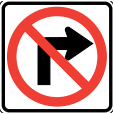 |
Prohibits drivers from making a right turn. |
| 24. |  |
Warns drivers that they are approaching a two-way traffic area. |
| 25. |  |
Prohibits parking in a specific area or zone. |
| 26. |  |
Instructs drivers to yield to uphill traffic. |
| 27. |  |
Indicates a one-way street or roadway. |
| 28. |  |
you may only stop your vehicle in the area indicated by the sign (typically the shoulder of the road) in emergency situations. |
| 29. | 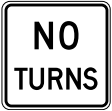 |
You may not turn neither right nor left at an intersection marked by the “NO TURNS” sign. Traveling straight through the intersection is your only option. |
| 30. |  |
Drivers may turn left on a green light after yielding to oncoming traffic. |
| 31. |  |
Prohibits drivers from passing other vehicles. |
| 32. |  |
Traffic flows only in the direction of the arrow. |
| 33. | 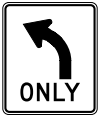 |
Requires drivers to make a left turn and prohibits other movements. |
| 34. |  |
Allows drivers to turn left or right, but not proceed straight |
| 35. |  |
Indicates that drivers should avoid entering an intersection unless they can completely clear it. This sign serves to prevent vehicles from obstructing the flow of traffic by getting stuck in the middle of the intersection. |
| 36. |  |
his sign encourages slower-moving vehicles to keep to the right side of the road, allowing faster-moving vehicles to pass on the left. |
| 37. |  |
Direct drivers to keep to the right of the traffic island or divider. |
| 38. |  |
Indicates the presence of multiple railroad tracks at a crossing. This sign serves as a warning to drivers that they are approaching a railroad crossing with three sets of tracks to be aware of and exercise caution. |
| 39. |  |
Vehicles traveling straight ahead should merge into the left lane |
| 40. |  |
The road ahead is completely closed to all traffic. |
| 41. |  |
This sign informs you there is roa work ahead and also cautions you to slow down. |
| 42. |  |
The sign to the left shows a flagger is controlling traffic ahead. As shown below, flaggers use STOP and SLOW paddles or a red flag to signal you to stop or slow down. Pay special attention to flaggers when approaching and traveling through a work zone. |
| 43. |  |
There is maintenance or construction work being carried out on the shoulder of the road ahead |
| 44. |  |
Indicate that there is an airport located in the vicinity or in the direction ahead. |
| 45. |  |
A rest area located approximately one mile ahead on the roadway. This sign is used to inform drivers of an upcoming opportunity to take a break, use restroom facilities, stretch their legs, or take a rest from driving. |
| 46. |  |
Be prepared to adjust your speed or position when you see a vehicle with one of these signs. |
| 47. |  |
Especially slippery conditions exist when wet. In wet weather, reduce your speed and increase your following distance. Do not accelerate or brake quickly. Make turns at a very slow speed. |
| 48. |  |
There is a merge point ahead where two lanes of traffic will come together. This sign serves as an advanced warning to drivers, informing them to be prepared for vehicles entering the roadway from another lane or ramp. |
| 49. |  |
The highway aheadis split into two separate roadways bya median or divider and each roadway isone-way. Keep right. |
| 50. |  |
The highway aheadno longer has a median or divider. Traffic goesin both directions. Keep right. |
| 51. |  |
The “TWO-WAY TRAFFIC AHEAD” sign is used to indicate that the current road is about to transition from a one-way road or divided highway to a two-way road. This sign serves as an advanced warning to drivers, notifying them that they will be encountering oncoming traffic in the opposite direction. |
| 52. | 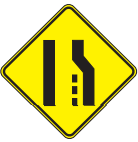 |
These signs tell you one lane on a multi-lane roadway will end ahead. In this example, the traffic in the right lane must merge left. |
| 53. |  |
A traffic signal is present at the intersection ahead. You may not be able to see it because of a curve or hill. If the light is red (or if the light has just turned green), a line of vehicles may be stopped ahead. When you see this sign, slow down and prepare to stop, if necessary. |
| 54. |  |
Watch for people entering a crosswalk or crossing your path. Slow down and be prepared to stop. A second sign with an arrow may show the actual location of the crosswalk. |
| 55. |  |
This sign is placed in advance of a point where two roadways meet. It means merging is not necessary because the entering traffic uses a new lane that has been added to the roadway. |
| 56. |  |
This sign serves as a warning to drivers that there is an intersection ahead where another road crosses the one they are currently traveling on. |
| 57. |  |
A stop sign is ahead. Slow down and be ready to stop. |
| 58. |  |
A yield sign is ahead. This sign serves as an advanced warning to drivers, indicating that they should be prepared to slow down, stop if necessary, and yield to oncoming traffic or crossing pedestrians. |
| 59. |  |
Con đường phía trước thay đổi hướng gấp. Trước khi bạn đến một khúc cua gấp như vậy, hãy giảm tốc độ như bạn làm khi rẽ tại một giao lộ. |
| 60. |  |
The road curves ahead to the left. You need to slow down, stay in the center of your lane, and prepare to navigate through the left-bending curve. |
| 61. |  |
An intersection is ahead. Be alert for vehicles entering the road on which you are traveling. |
| 62. |  |
The road ahead winds with a series of turns or curves. On all curves, slow down for better control. |
| 63. | 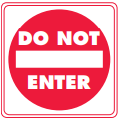 |
Red and White Regulatory Sign. Follow the sign’s instruction. For example, DO NOT ENTER means do not enter the road or ramp where the sign is posted. |
| 64. |  |
WRONG WAY Sign. If you enter a roadway against traffic, DO NOT ENTER and WRONG WAY signs may be posted. When it is safe, back out or turn around. If you are driving at night, you will know you are going the wrong way if the road reflectors shine red in your headlights. |
| 65. |  |
Yellow and Black Circular Sign or X-shaped Sign. You are approaching a railroad crossing. Look, listen, slow down, and prepare to stop. Let any trains pass before you proceed.
Many railroad crossings also have a blue and white sign to tell you what to do if there is an emergency on or near the tracks, or if your vehicle has stalled on the tracks. |
| 66. |  |
5-sided Sign You are near a school. Drive slowly and stop for children in the crosswalk. |
| 67. |  |
This sign is posted in areas where deer frequently cross and crashes with deer have occurred. |
Traffic Sign Solors and Meanings
By understanding the meanings of different sign colors, you’ll be well-prepared to succeed on your first attempt.
| Color | Meaning | Examples |
| Red | Regulatory signs, stop, and prohibition | Stop sign, Do Not Enter sign, No Parking sign |
| Yellow | General warning | Warning Signs sign, Advisory Speed sign |
| Green | Directional guidance and informational | Guide signs, Hospital sign, Mile Markers sign |
| Black/White | Regulatory signs and specific information | Speed Limit sign, One Way sign |
| Brown | Recreation and cultural interest areas | National Park signs, Scenic Route signs |
| Orange | Construction and maintenance warnings | Road Work Ahead sign, Work Zone signs |
| Blue | Motorist services and information | Gas station signs, Rest Area signs |